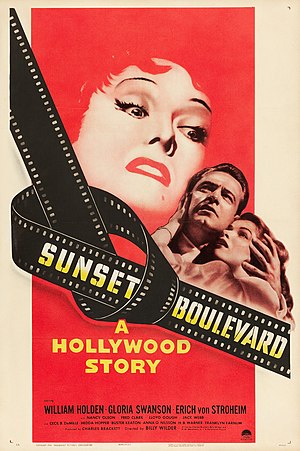Sunset Boulevard
Jump to navigation
Jump to search
| Sunset Boulevard | ||||||||||||||||
|---|---|---|---|---|---|---|---|---|---|---|---|---|---|---|---|---|
This film has been preserved in the National Film Registry in 1989.
| ||||||||||||||||
 | ||||||||||||||||
|
Sunset Boulevard (sometimes known as SUNSET BLVD.) is a 1950 American film noir directed and co-written by Billy Wilder, and produced and co-written by Charles Brackett. It was named after the thoroughfare with the same name that runs through Los Angeles and Beverly Hills, California.
Why It Rocks
- Filmmakers turning the camera on themselves throughout the history of the medium is common throughout the medium. But while most of those previous movies were comedies; affectionate stories with occasional sarcasm (i.e. Show People and Boy Meets Girl), Paramount would notably take a more hard-edged approach with its unofficial trilogy of The Last Command, Sullivan's Travels, and this film, as these films would offer some of the darkest accounts of the industry on film.
- The film’s about a movie star who lost her hold at the box office, and it was originally meant to be a comedy, but an angle involving a Midwest screenwriter becoming a sort of paid escort to the star (given director Billy Wilder had a background as a gigolo and a screenwriter himself), led to the film becoming still a bit of a comedy, but now something dark and sordid, with elements of horror and film noir mixed in.
- The story is still very relevant for its look at the way the industry can discard aging actresses as easily as it once built them up—a point underscored by the film’s fascinating overlap of fiction and reality. Gloria Swanson was one of many silent film stars unable to properly transition to sound films, due more to her age and her overly expressing acting than to her voice. These elements would be translated to Wilder’s depiction of faded star Norma Desmond. Swanson would accept the project wholeheartedly, offering her photographs and mementos for sets, and allowing Wilder to use a clip from 1929's Queen Kelly – which makes since considering Erich von Stroheim played Norma's butler. Swanson brings a silent-era flamboyance to Desmond that meshes perfectly with the iconic dialogue by Charles Brackett and Wilder (such as “I am big; it’s the pictures that got small!”) while keeping the character believable and even sympathetic. It’s no small feat for a film that in every regard straddles the line between reality and fantasy, tragedy and satire.
- Joe Gillis – the doomed screenwriter – was a breakout role for William Holden, who was previously typecast as affable romantic leads after a 1939 film
- Betty Schaefer, a script reader who tries to save Gilles, seems to be based on Audrey Young, an actress Wilder meet.
- There's just enough truth to the story and characters in the film to keep viewers unsettled. This includes incorporating the Paramount lot, where Cecil B. DeMille was filming Samson and Delilah, or featuring real stars of the silent film era as the "waxworks" bridge players. In fact, Wilder's usage of reality in the film was ahead of its time, as the industry wasn't even prepared for it.
- On top of that, Wilder created a psychological honesty about his characters that was as scary as it was transfixing.
- The Grand Guignol efforts along with the rats, haunted mansion, slashed wrists, or the fact that the story’s narrated by a ghost slightly help to distance the audience from what the film’s truly about. The film’s often a disguised horror film that’s really about disillusionment and self-loathing.
- Clever costume design by Edith Head, as the costumes for Swanson keep one foot in stylish modernity and another in a bygone dream world. In the end, there's a subtle vintage touch to each of Swanson’s outfits, such as peacock feathers or old pieces of costume jewelry.
- The final scene is one of Hollywood’s most legendary, with Norma Desmond descending a staircase into the camera, into madness, and into the audience’s psyches, all the while believing she is performing a scene for DeMille.
- This film lead to other filmmakers doing expose films, such as All About Eve and The Bad and the Beautiful.
The Only Bad Quality
- Some of the film's characters can be hard to relate to for today's standards. Though this is partially justified since they're showing us the dark side of Hollywood.
Comments
Loading comments...